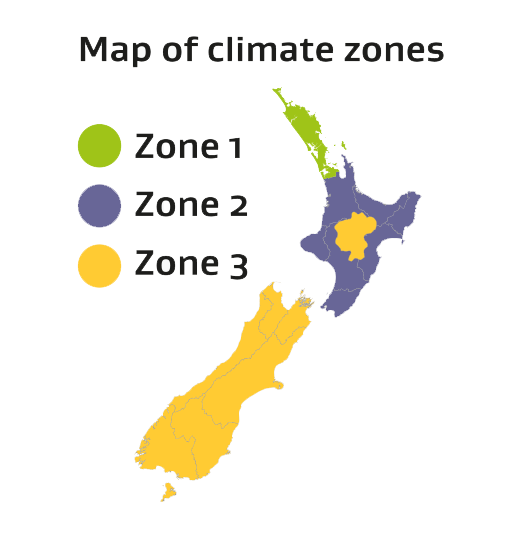![]() Ceiling and underfloor insulation has been compulsory in all rental homes since 1 July 2019. The healthy homes insulation standard builds on the current regulations and some existing insulation will need to be topped up or replaced.
Ceiling and underfloor insulation has been compulsory in all rental homes since 1 July 2019. The healthy homes insulation standard builds on the current regulations and some existing insulation will need to be topped up or replaced.
This page explains the healthy homes insulation standard with compliance dates beginning 1 July 2021. For information on the current insulation requirements, visit the current insulation requirements page.
Insulation stops heat escaping from the house. In general, the better insulated a home is, the more it will retain heat. This means:
- it will usually cost less to heat the property
- the property will be drier
- the property will be less prone to mould.
Between 1 July 2021 and 1 July 2025, all private rentals must comply with the healthy homes standards within certain timeframes from the start of any new, or renewed, tenancy.
Use the compliance timeframes decision tool to find out when your rental property needs to comply
All boarding houses must have complied by 1 July 2021. All houses rented by Kāinga Ora (formerly Housing New Zealand) and registered Community Housing Providers must comply by 1 July 2024.
More detail about the insulation standard is available in the guidance document. [PDF, 2.2 MB]
Landlords that don’t meet their obligations under the healthy homes standards are in breach of the Residential Tenancies Act 1986. They may be liable for exemplary damages of up to $7,200.
What is the required level for insulation?
Insulation requirements are measured by R-value. R-value is a measure of resistance to heat flow. The higher the R-value, the better the insulation.
Minimum R-values vary across New Zealand. Use the map below to check what zone your property is in.
Climate zones for properties which received building consent before 3 November 2022:
|
|
Zone 1 — ceiling R 2.9, underfloor R 1.3 Zone 2 — ceiling R 2.9, underfloor R 1.3 Zone 3 — ceiling R 3.3, underfloor R 1.3 |
The R-value of new insulation is on the product packaging. For existing insulation, check in the ceiling or underfloor space as the R-value from the packaging may be stapled to a beam. You can also measure the thickness yourself or consult a professional insulation installer. Existing ceiling insulation that was installed before 1 July 2016 must be at least 120mm thick.
Ceiling insulation that is less than 120mm thick is acceptable if the landlord can prove:
- the insulation’s R-value met the minimum R-values (2.9 or 3.3 depending on the climate zone) when it was installed, and
- the insulation’s thickness has not degraded by more than 30% (compared to when it was installed).
Insulation must be installed in accordance with New Zealand Standard 4246:2016. [PDF, 6 MB]
All existing insulation must still be in reasonable condition to meet the requirements. This means there should be no mould, dampness, damage or gaps.
New builds and consented renovations
The six climate zones in the 2021 Building Code update follow territorial authority boundaries. All new builds and properties which undergo renovations requiring consent will need to be compliant with the minimum insulation requirements in the 2021 Building Code update.
The three climate zones under the healthy homes standards reflect the levels of insulation required for rental properties to meet the insulation standard.
Any new build or renovated property that is compliant with the updated 2021 Building Code insulation requirements will be compliant with the healthy homes insulation standard. This is because the updated 2021 Building Code insulation requirements exceed the healthy home standard insulation requirements.
Landlords that install or top up ceiling and underfloor insulation in their existing rental properties will need to comply with the healthy homes insulation standard, but do not need to meet the new, higher 2021 Building Code insulation requirements (provided the property is not undergoing renovations that require building consent).
More information about the 2021 Building Code insulation requirements(external link)
Exemptions to the insulation standard
There are three specific insulation exemptions. The information here is an overview. More information on these exemptions is available in Subpart 3 of the Healthy Homes Standards Regulations(external link).
1. Access is impracticable or unsafe
Some areas of some homes may be unsafe or not reasonably practicable to access. This may be due to:
- their design
- limited access
- potential for substantial damage
- health and safety reasons.
There is an exemption for parts of homes where a professional installer is unable to access and/or insulate, until this becomes possible (for example when a property is re‑roofed).
2. Partial exemption for certain underfloor insulation
If the rental home has existing underfloor insulation that was installed when the home was built or converted. This insulation must still be in reasonable condition. Landlords must have a copy of any compliance documents that shows the home met the requirements of the time. For example:
- code compliance certificate
- certificate of acceptance
- another relevant compliance document.
3. Ceilings and floors with other habitable spaces directly above or below
The third exemption applies to areas of ceilings or floors where there are other habitable spaces directly above or below. This might be another floor of the same property or another apartment. These areas do not require insulation to meet the healthy homes insulation standard.
These three exemptions are in addition to the general exemptions.
Does your current insulation meet the standard?
Landlords who have installed new insulation since 1 July 2016 should already meet the healthy homes insulation standard. These landlords probably won’t need to do anything further to comply with the healthy homes standards. They should still check that the insulation is in a reasonable condition.
Some landlords didn’t need to improve their existing levels of insulation under the current requirements that came into force on 1 July 2019. These landlords may need to do so to meet the healthy homes standards.
Managing asbestos related risks
Landlords must manage any asbestos-related risks when work is being done at their property.
This is to protect the health and safety of tenants, neighbours, contractors and anyone else who may be affected.
Further information
The insulation standard is one of five healthy homes standards. Find out about the other healthy homes standards:
- Heating standard
- Ventilation standard
- Moisture ingress and drainage standard
- Draught stopping standard
2022 Building Code updates
2022 Building Code updates(external link) — Building Performance
Transition to the new Building Code insulation and glazing requirements is in 3 phases.
Phase 1 – Homes with building consent applied for from 3 November 2022
Insulation requirements for windows, skylights and doors increased on 3 November 2022. The tool automatically suggests corresponding default R-values of 0.37.
Phase 2 – Homes with building consent applied for from 1 May 2023
Insulation requirements for wall, floor, and roof increase on 1 May 2023. Window, skylight and door requirements increase further, except for windows and doors in the upper North Island.
Phase 3 – Homes with building consents applied for from 2 November 2023
Window and door glazing requirements increase further to R0.46 in the northern-most parts of New Zealand on 2 November 2023.
Last updated: 07 June 2024


